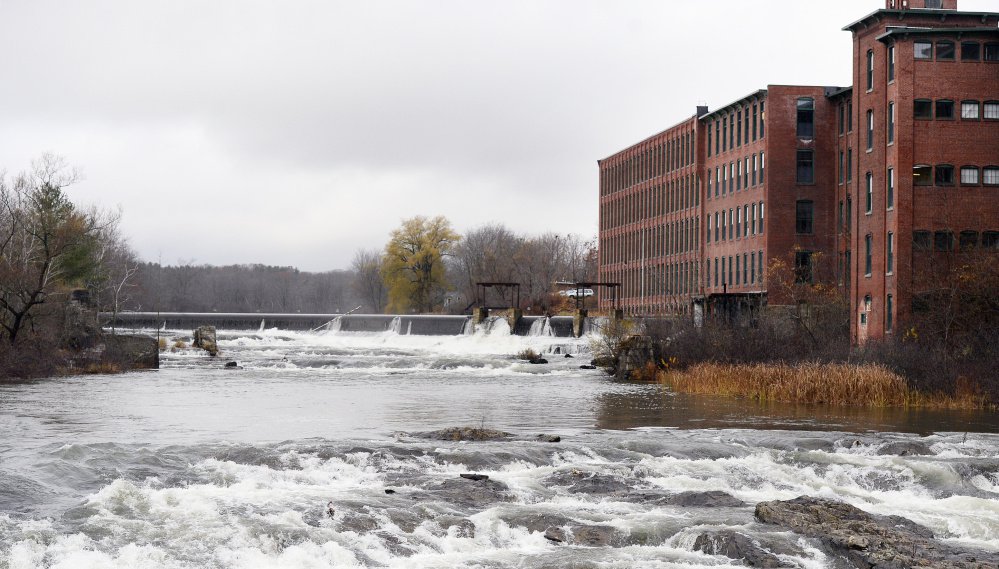Birders and naturalists are celebrating the proposed removal of the Saccarappa dam on the Presumpscot River in Westbrook. But some fishermen are taking a wait-and-see approach to the proposal, which was filed with the Federal Energy Regulation Commission on Tuesday.
The plan calls for removing the two dam headwalls on either side of an island at Upper Saccarappa Falls and installing a fish passage ladder around Lower Saccarappa Falls. The application also calls for reconstruction of the river bottom at the upper falls to allow fish easier passage. The dams could be removed by 2020.
Sappi North America is seeking approval to remove the dam and make the other changes in the river from FERC, which has the authority to approve Sappi’s application to cease operating its hydroelectric facility at the falls. The agreement is also subject to approval by the city of Westbrook and the Maine Department of Environmental Protection.
“I would say based on our experience on the Penobscot River after dam removal there, given the river fish that have the potential to come back here, like herring and shad, I think there is no doubt this will have huge benefits for wildlife,” said Maine Audubon biologist Susan Gallo. “I think the river will just get richer in terms of bird life when the fish populations come back.”
However, some fishermen say the future health of the river will depend on how well the project – including the new fish ladder and the reconstructed river bottom – turns out. Just removing the dam is not enough.
“This all has to function properly for the project to actually restore fish passage,” said Steve Heins, an officer with the Sebago chapter of Trout Unlimited. “You count fish to determine that (after the changes are made).”
Heins said his group “saluted” the effort of the Friends of the Presumpscot River to push for a fish passage on the Presumpscot, one of Maine’s most heavily dammed rivers. But Heins is not convinced the fish passages as proposed will prove effective on the river, which runs about 24 miles from Sebago Lake to Casco Bay.
“The history of the Presumpscot is fascinating,” he said. “It used to have a unique strain of Atlantic salmon called ‘the Leaper.’ It is thought that the fish evolved its increased leaping ability to deal with the difficulty of the passage.”
Others, such as fly fisherman Matt Streeter, were more hopeful. Streeter said he’s only fished the Presumpscot a few times, but added: “Dam removal is always a good thing.”
Meanwhile, among Maine’s birding community, the dam coming out spelled good news for sea-run fish and bird life.
Gallo said the Presumpscot already attracts mergansers, cormorants, loons, kingfisher and herons. Removing another dam will increase the bio-diversity there, she said.
“It will improve wildlife habitat by not only opening up five more miles of river for migrating fish but also by allowing migrating fish access to the Little River, which is one of the largest tributaries of the Presumpscot River watershed,” said Rachelle Curran Apse, the Presumpscot Regional Land Trust executive director.
Maine Audubon staff naturalist Doug Hitchcox said Saccarappa Falls has become known as a good place to find Barrow’s goldeneye, a duck that is threatened in Maine, during the winter.
“It’s hard to get around the thought that any time you restore the natural flow in a waterway, it’s just going to have widespread positive effects on all wildlife,” Hitchcox said. “When the (bait) fish are running, there is an unbelievable number of osprey on the river. (My) high count from standing in one spot at one time is 18.”
Derek Lovitch, co-owner of the Freeport Wild Bird Center, who runs birding trips year-round, said the changes in the river could change water levels at the falls, and actually hurt birding opportunities for waterfowl during the winter. But, he added, the increase in sea-run fish still will improve the river’s overall ecosystem.
“In the big picture, any time the river is healthier, there are more fish and that means the better the birds will do and that’s good for birding,” Lovitch said.
Send questions/comments to the editors.



